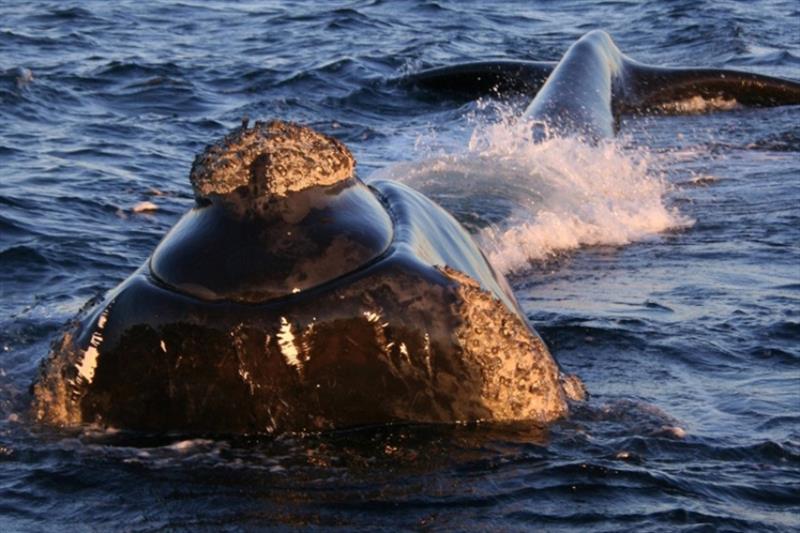
Adult female right whales key to recovery
by NOAA Fisheries 19 Nov 2018 16:38 UTC

A Southern right whale © NOAA Fisheries
Why is the endangered western North Atlantic right whale population growing far more slowly than those of southern right whales, a sister species also recovering from near extinction by commercial whaling?
NOAA Fisheries researchers and colleagues looked more closely at the question and have concluded that preserving the lives of adult females in the population is by far the most effective way to promote population growth and recovery. Most of these deaths are attributed to entanglement in fishing gear and collisions with ships. The findings are reported in Royal Society Open Science.
"Had North Atlantic right whales increased at the annual rate that we show they are capable of, the population number would be almost double what it is now and their current situation would not be so dire," said Peter Corkeron, who is lead author of the paper and heads the large whale research effort at NOAA Fisheries' Northeast Fisheries Science Center.
The North Atlantic right whale, Eubalaena glacialis, is one of three species of right whales. Of the three, it lives in the most industrialized habitat and migrates close to shore.
From 1970 to 2009, 80 percent of all North Atlantic right whale deaths (70 of 87) for which the cause is known were human-induced, mainly from entanglement in fishing gear and collisions with ships. By comparison, most deaths of southern right whales that have been observed were calves in their first year of life and very few were directly attributable to human activities.
Calving rates are one measure
"We studied four populations of right whales, three from the southern populations off eastern South America, southern Africa and southwest Australia plus the western North Atlantic population, that had comparable time-series data and minimum counts of calves known to be born each year," said Corkeron. "Intensive aerial surveys of North Atlantic right whale calving habitat began in 1992, so that marked the start of our comparison."
The researchers compared calf counts from 1992 to 2016 for each of the four populations. By this index, the annual rate of increase of North Atlantic right whales (about 2 percent per year) was much less than of southern right whales (between 5.3 and 7.2 percent per year).
Estimating the intrinsic growth rate for North Atlantic right whales
The researchers then looked at the extent to which this difference in annual increase is related to ongoing human-caused injuries and deaths rather than ecologically intrinsic growth rates for each population.
They constructed a population projection model for female North Atlantic right whales, using the highest annual survival estimates available from recent resighting analysis using photo identifications, and assuming four years between births. This resulted in an estimated 4 percent intrinsic rate of increase, approximately twice what has been observed.
The model results also demonstrated that deaths of adult females accounted for about two-thirds of the difference between the estimated intrinsic growth rate and what has been observed.
Other factors
Researchers also looked at other factors and differences in the North Atlantic and southern populations. Eighty-three percent all individual North Atlantic right whales have been entangled in fishing gear at least once in their lives, and 59 percent have been entangled two or more times.
The energy demands from the drag associated with entanglement can reduce the likelihood that a female can successfully reproduce. Years between births also increases for females given the recovery period needed from the physical costs of entanglements, which can last from months to years. By comparison, entanglement in fishing gear is almost nonexistent for southern right whales.
Paper results from international effort
In addition to Peter Corkeron and Richard Pace from NOAA Fisheries' Northeast Fisheries Science Center, co-authors of this study are Philip Hamilton, Anderson Cabot Center for Ocean Life at New England Aquarium; John Bannister, Western Australian Museum; Peter Best and Els Vermeulen, University of Pretoria, South Africa; Claire Charlton, Curtin University, Australia; Karina Groch, Projeto Baleia Franca/Instituto Australis, Brazil; Ken Findlay, Cape Peninsula University of Technology, Cape Town, South Africa; and Victoria Rowntree, University of Utah and Instituto de Conservación de Ballenas, Buenos Aires, Argentina.
Coauthors John Bannister of the Western Australian Museum and Peter Best of the University of Pretoria passed away before this study was published.